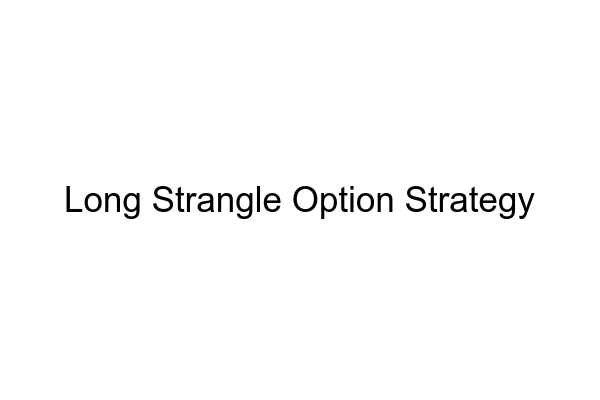Long Strangle Option Strategy

Long Strangle Option Strategy
What are the characteristics of this option strategy?
A long strangle refers to a type of options strategy involving the purchase of an out of the money call option and out of the money put option, with the same expiration date. This strategy requires that the call and put options have identical expiry dates, but with different strike prices. A long strangle strategy seeks to benefit from a large price move in either direction.
Is this a bullish, bearish or neutral strategy?
The long strangle strategy is a neutral strategy. It seeks to take advantage of a large move in either direction in the price of an underlying asset.
Is this a beginner or an advanced option strategy?
The long strangle strategy is an advanced option strategy. It is not for novice traders and should only be used by experienced traders.
In what situation will I use this strategy?
The long strangle strategy is best used when you believe a stock will make a large move, but you don’t know which direction it will go. This strategy is typically used when volatility in the underlying stock is high, but the cost of options is also high.
Where does this strategy typically fall in the range of risk-reward and probability of profit?
The risk-reward ratio of a long strangle strategy is high, while the probability of profit is moderate. The underlying stock needs to move significantly in either direction to make a profit, which increases the risk of the strategy. On the other hand, the strategy offers a good chance of profiting when the underlying stock moves significantly.
How is this strategy affected by the greeks?
The long strangle strategy is affected by the “greeks,” which are the key risk measures associated with option strategies. Delta, gamma, vega, theta and rho are the five greeks that affect the long strangle strategy. Delta measures the sensitivity of an option’s price to changes in the underlying security’s price. Gamma measures the rate of change in delta for a one-point move in the underlying stock. Vega measures the option’s sensitivity to changes in volatility of the underlying security. Theta measures the sensitivity of the option’s price to the passage of time. Rho measures the sensitivity of the option’s price to a one-point move in the interest rate of the underlying security.
In what volatility regime (i.e., VIX level) would this strategy be optimal?
The long strangle strategy is usually optimal when the VIX is somewhere between 10 and 20. This range is considered to be high volatility and provides ample opportunity for the underlying stock to make a large move in either direction.
How do I adjust this strategy when the trade goes against me? And how easy or difficult is this strategy to adjust?
To adjust this strategy when the trade goes against you, you should add additional options to the trade by purchasing additional out of the money call and/or put options. This strategy is moderately easy to adjust, as long as you know how to price options.
Where does this strategy typically fall in the range of commissions and fees?
The long strangle strategy typically has high commission and fee costs, as this strategy requires two different options to be purchased.
Is this a good option income strategy?
The long strangle strategy is not typically used as an option income strategy, since the underlying stock needs to move significantly in either direction in order to make a profit. It is more suited as a directional strategy.
How do I know when to exit this strategy?
The long strangle strategy should be exited when the underlying stock moves significantly in either direction. If the stock moves in the direction of the purchase option, the strategy should be exited at a profit. If the stock moves in the opposite direction, the strategy should be exited at a loss.
How will market makers respond to this trade being opened?
Market makers will typically respond positively to the opening of a long strangle, as it usually entails the purchase of both call and put options.
What is an example (with calculations) of this strategy?
For example, let’s say MSFT stock is trading at $277 per share. You decide to initiate a long strangle strategy and buy one out of the money call option with a $285 strike price and an out of the money put option with a $270 strike price. The cost of the two options is $3.05 and $4.00 respectively, so your total cost of the trade is $7.05. If the stock moves up to $295, the call option will be in the money and have a value of $10.00. If the stock moves down to $260, the put option will be in the money and have a value of $10.00. Your total profit from the trade will be $2.95.
How MarketXLS Can Help
MarketXLS provides a unique suite of option strategies and calculators including the Iron Condor Excel Template and Short Guts, Long Guts Option Strategy. These resources help traders save time and maximize profits when trading options. With MarketXLS, traders can access real-time market data, calculate risk exposure in fractions of a second, and execute trades in real-time. With all the power of Microsoft Excel, MarketXLS gives traders the tools they need to succeed in the options market.
Here are some templates that you can use to create your own models
Long Strangle Option Strategy
Calendar Strangle
Strip Strangle
Strap Strangle
Long Straddle Option Strategy
Calendar Straddle
Long Put Synthetic Straddle
Synthetic Short Straddle with Calls
Synthetic Short Straddle with Puts
Short Albatross Spread
Search for all Templates here: https://marketxls.com/templates/
Relevant blogs that you can read to learn more about the topic
Long Strangle Option Strategy (Using Excel Template)
Becoming a Pro by Knowing the Option Delta Formula
Benefits of Being Delta Positive
Understand What a Strangle in Options Is
“Maximizing Your Profits with Out of Money Call Options”
